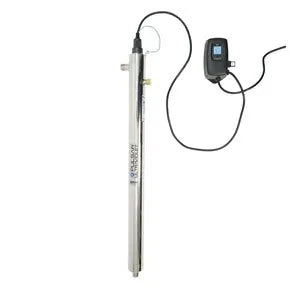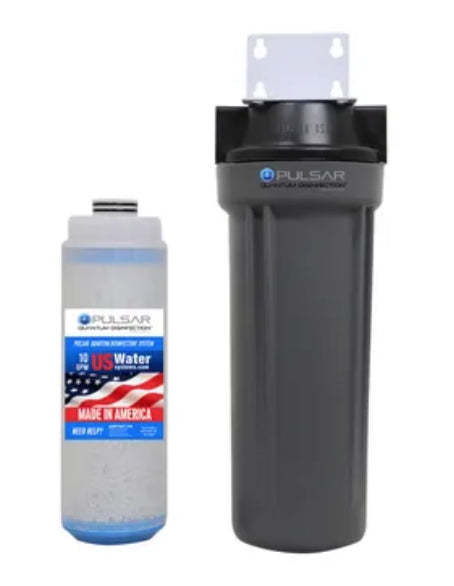Disinfection Systems
-
Pulsar Ultraviolet Disinfection System | 10-20 GPM
Unlike chemical approaches to water disinfection, UV rapidly and effectively inactivates microorganisms through a physical process. When bacteria, viruses, and protozoa are exposed to the germicidal wavelengths of UV light, they are rendered incapable of reproducing and infecting. UV light has demonstrated effectiveness against...- From $995.00
$1,658.34- From $995.00
- Unit price
- per
-
Pioneer Whole-House Lead, Cyst & PFOA/PFOS Removal System
Pioneering Protection Designed at the 0.5-micron nominal filtration level, the Pioneer removes and/or reduces soluble lead and particulate lead, heavy metals, PFOA/PFOS, chlorine, and chloramine, including > 99.95% of cysts. Soluble/Ionic & Particulate Lead: The binders within the Pioneer are specifically designed to react...- From $1,295.00
$2,356.90- From $1,295.00
- Unit price
- per
-
Pulsar Quantum Disinfection System - 10 GPM
The Pulsar Quantum Disinfection System™ is a true eco-friendly, carbon neutral water disinfection solution. This system utilizes patented technology, which harnesses the quantum mechanic principles of electron movement to create surface catalytic sites that strip away viruses, bacteria, and pathogens. This system does not...- $499.00
$908.18- $499.00
- Unit price
- per
-
US Water Systems Pulsar Max Plus Ultraviolet Disinfection System | Up To 20 GPM
When it comes to rainwater harvesting, ensuring the highest purity standards is essential. The Pulsar Max Plus Ultraviolet Disinfection System is a top recommended solution for rainwater treatment, delivering unmatched peace of mind and premium-quality water directly to every tap in your home. With...- $2,300.00
$3,833.34- $2,300.00
- Unit price
- per
-
Pulsar Mini UV System 3 GPM
Durable, compact, and sleek the Pulsar Mini UV System is a professional grade system designed to disinfect water at its point of use. This system features a stainless steel body, is eco-friendly, carbon-neutral, and energy-efficient. The Pulsar Mini is the perfect system for under...- $496.34
$903.34- $496.34
- Unit price
- per
-
US Water Systems Pulsar Max Ultraviolet Disinfection System | Up To 20 GPM
When it comes to rainwater harvesting, ensuring the highest purity standards is essential. The Pulsar Max Ultraviolet Disinfection System is a top recommended solution for rainwater treatment, delivering unmatched peace of mind and premium-quality water directly to every tap in your home. Rainwater can...- $1,995.00
$3,267.81- $1,995.00
- Unit price
- per
-
US Water Hi-Flow Pulsar Quantum Disinfection System - 20 GPM
Quantum Disinfection™ is the future of disinfection… and the future is here! Imagine using just a 10 inch filter housing to get bacteria-free, safe, disinfected water, with no electricity, no chemicals, no UV bulbs that have to be disposed of properly because they have...- $999.00
$1,818.18- $999.00
- Unit price
- per
-
Matrixx Liquid Chlorination System
Featuring an advanced proportional injection system and an oversized contact tank, the Matrixx Liquid Chlorination System is engineered to provide cost-effective disinfection for your whole house. Chlorination is one of many methods that can be used to disinfect water. This method was first used...- From $4,136.36
$7,528.18- From $4,136.36
- Unit price
- per
Compare Our Water Technologies
Pulsar™ Ultraviolet Disinfection

UV, as it is often called, is also a physical method for the disinfection of water in that no chemicals are added. An ultraviolet light operates at 254 nanometers (nm) and, as water containing microorganisms passes by the UV light, their DNA is altered so that it cannot reproduce. Since these microorganisms cannot replicate, they are essentially dead. As mentioned, UV adds nothing to the water and while it does use power, it generally costs only about $30 a year to operate.
Advantages:
- Moderate initial cost
- No harmful chemicals added
- No disinfection byproducts
Disadvantages:
- Uses electricity
- Requires proper contact time
- Bulb contains mercury and must be disposed of properly
- When the power goes out, your plumbing system can be compromised with bacteria
- Controller (ballast) needs periodic replacement
Pulsar™ Quantum Disinfection

Quantum Disinfection is the future of disinfection and the future is here! Imagine using just a 10 inch filter housing to get bacteria-free, safe, disinfected water, with no electricity, no chemicals, no UV bulbs that have to be disposed of properly because they have mercury inside, no ballast to replace and no carbon footprint.
Advantages:
- Low initial cost
- Removes bacteria, cysts, and virus
Disadvantages:
- Algae and iron can plug it quickly
Chlorination

The disinfection water treatment of choice for many years, chlorine is starting to decline in popularity due to newer, better, and more economical methods. Chlorine and chloramine (a related chemical) are still the methods of choice for disinfecting water in most municipalities, but homeowners are often hesitant to use chlorination due to the sheer size of the system, the dangerous disinfection byproducts produced by chlorination, and the service required to keep the system operational.
Advantages:
- Chemical disinfection is effective at killing bacteria
- Can measure the amount in the water
- Effective at killing algae
Disadvantages:
- Requires 20 to 30 minutes of contact time, so a large retention tank is needed
- Troublesome technology in that chlorine tends to crystallize and plug at the injection point
- Produces disinfection byproducts that are carcinogenic
- Corrosive to metals close to chlorine













